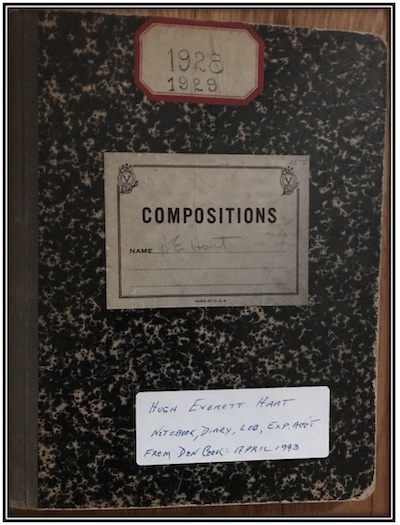Journal details notes of young ornithologist who helped secure swamp as bird sanctuary
By Catherine Cooper, Orleans County Historian
Illuminating Orleans, Vol. 3, No. 17

It contains a series of entries regarding the bird population of “The Swamp”, as the wildlife area in the Town of Shelby is commonly known. The author, Hugh Everett Hart, was a keen young ornithologist and oologist who graduated from Medina High School in 1922.
1928, June 4
“Just a notation here as to the weather. It has been very cold so far this year. I have a furnace fire going at present in order to keep warm. Rain. Frosts at night last week.”
1928, June 7
“To Swamp. Found nothing in 1 hr ramble. Looked for Ceruleans and Marsh Wren.
Set 21 eggs, Ring-necked Pheasant, young Red wings, Swamp Sparrow, Barn Swallow. Mosquitos very big and hungry.”
1928, June 10
“Roy Hill and I went out to the Swamp south of John Bannister’s today to look principally for Ceruleans. I had been to this piece of woods last week and heard the birds but could not locate any nests and then had Roy go today as he can find them when others cannot.
We entered the swamp and searched faithfully for over one hour in the oak grove but could not find anything. The birds were not heard or seen. Roy found a Yellow Warbler nest with one egg, a Yellow Warbler nest with 4 eggs, one Cowbird egg. Cowbird egg was broken.
Next, we located a nest of Redstart, 3 eggs. Found nest of Song Sparrow containing five fresh eggs. Flushed a Woodcock, a very large bird and somewhat slow in arising from the ground. The weather has provided much food for them lately and they are very fat at this time of year.
The season has been very backward this year for the birds as you can see by the late sets as told above.
There does not seem to be one half the birds nesting in the Swamp now as there was last year. This fact seems to be the same every year, as it gets harder and harder to locate a number of nests in an afternoon ramble when a few years back, one could find hundreds in a few hours.
There are no Marsh Wrens this year in the swale near Bedine’s, no Rails or Gallinules, no Ceruleans. The Redstarts are not nearly as numerous as before. I would not be surprised to have them all leave us in a few more years if this keeps up. Temp 60 degrees. Very cold breeze.”
1929, Feb.
“I sent two write-ups to The Oologist this month, one on Brown Creeper in Tonawanda Swamp, the other on the late nesting date for American Woodcock in New York State.
Also, Feb. 21, went to the Museum of Natural History in Buffalo to see Dr. Fish in regards to signing my application for a permit.
Came back with an impression of a very fine fellow, even if he did not help me. Had numerous excuses (Mostly Brackett, Game Warden in Buffalo).”
1929, May 19
“Warbler migration at its’ height.”
1929, May 24
“Date of first arrival of Cerulean Warbler in Orleans County.”
1931, March 21
“Killdeer seen and numbers of them heard.
During March I had my collection of eggs on display for 3 weeks at the Masonic Temple {Medina}. They created much interest, during this time I gave a talk to 35 Boy Scouts of the Presbyterian Church, Troop #31. They seemed very interested and asked many questions.
Published a list of the breeding birds of Orleans County in the Medina Daily Journal.
There is much talk here on making the Swamp into a Federal Bird Sanctuary.
Attended a dinner at Fairview Manor for the Sportsmen of Western New York (about 125).
Have been asked to speak at the Buffalo Museum of Natural History.
Have been asked to speak on bird life before the Social Culture Club of Orleans County.
Accepted both.”
In addition to those observations, the Notebook contains lists of Mr. Hart’s collection of bird eggs. Oology, the study of or collecting of birds’ eggs, was popular at the turn of the century. Museums amassed huge collections of exotic eggs; amateur collectors collected local specimens. However, it became apparent that this hobby had a detrimental effect on bird populations. The Migratory Bird Act of 1918 prohibited the collecting of birds’ eggs, except for scientific research.
In its time, oology was well represented in Orleans County. Dr. Frank H. Lattin published a magazine, The Oologist, from 1894 to 1905 while the egg collection acquired by Stuart Flintham in the early 1900’s is on display at the Hoag Library in Albion.

Canada Geese, a protected species at the Oak Orchard and Tonawanda Wildlife Areas. Courtesy of Doug Domedion.
Hugh Hart was involved in the designation of the Swamp as a federal migratory bird sanctuary. An electrical engineer by profession, he left Medina in 1935 to work with the Bell Aircraft Company in Buffalo and was later associated with General Motors in Detroit. He died in 1967.

































































